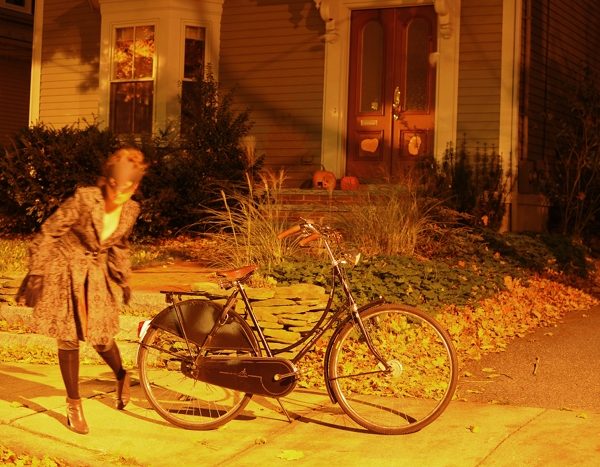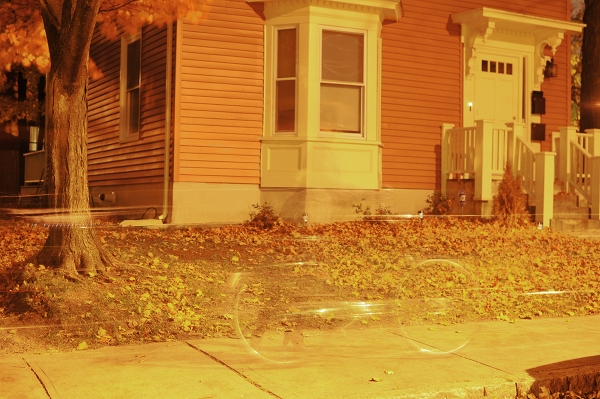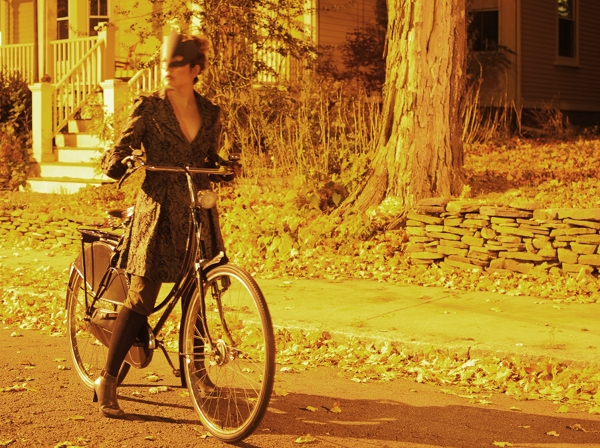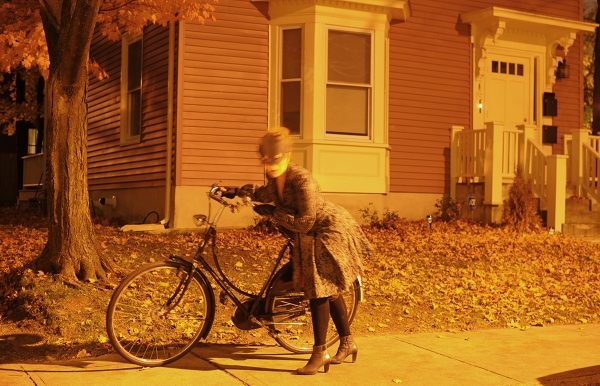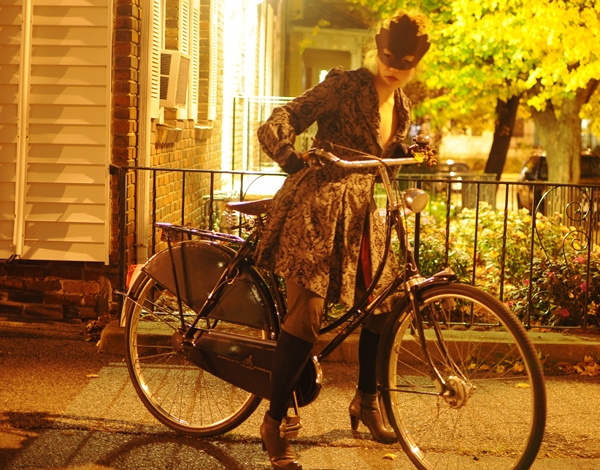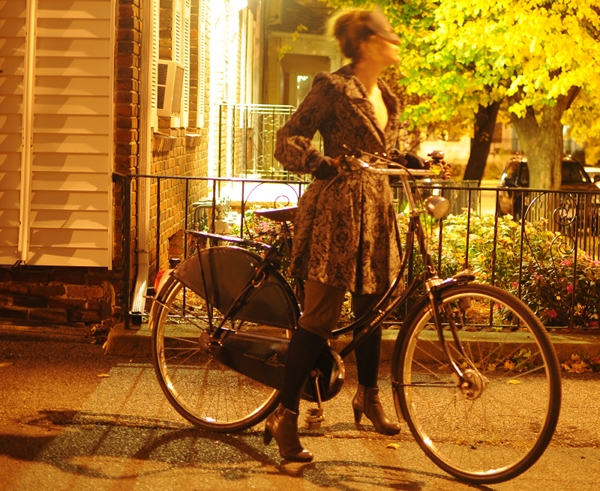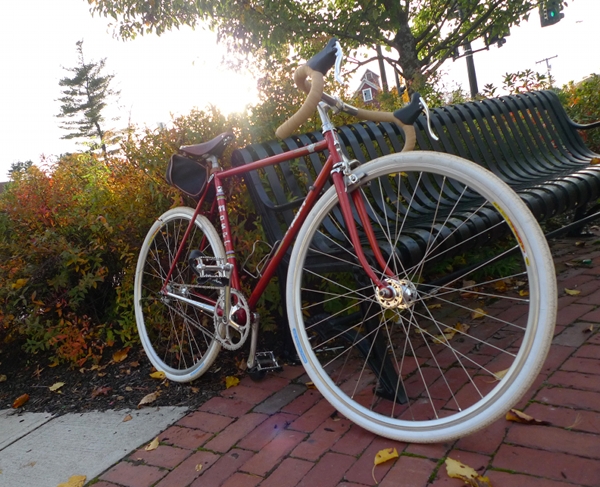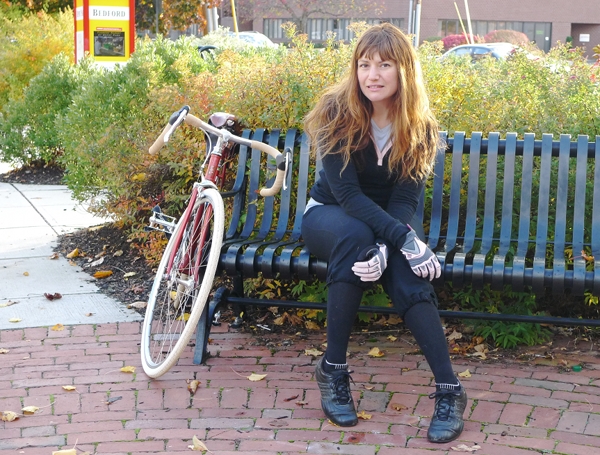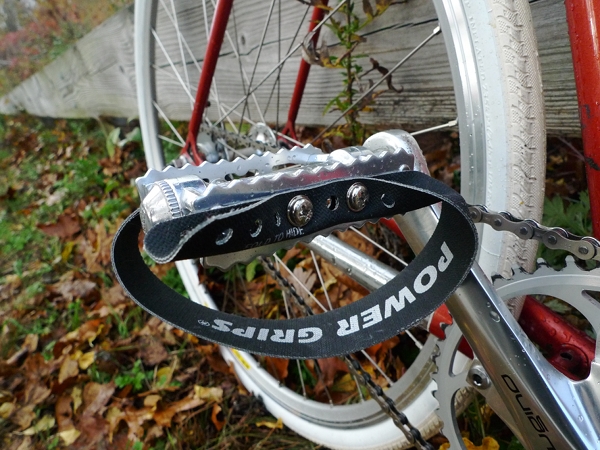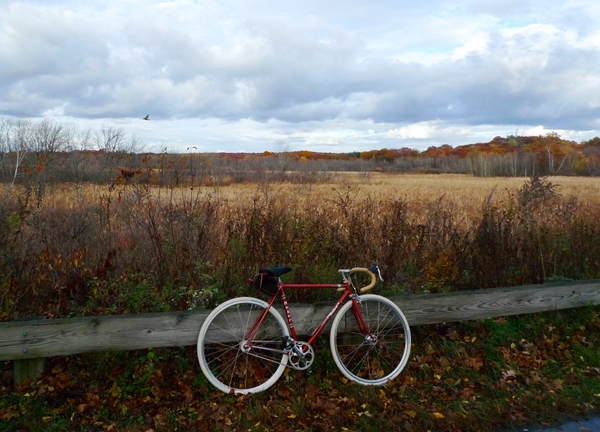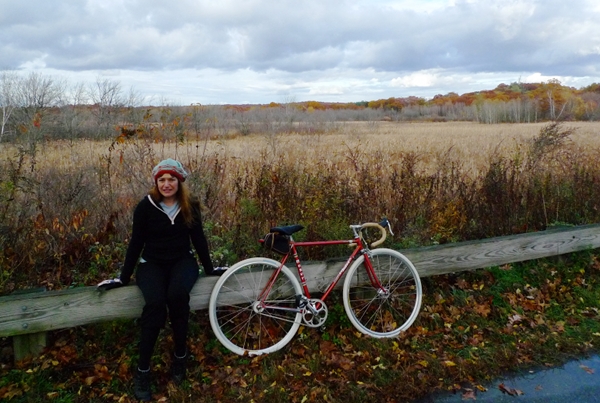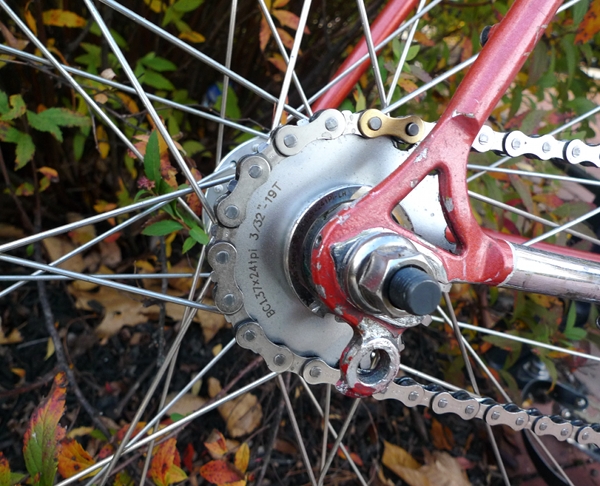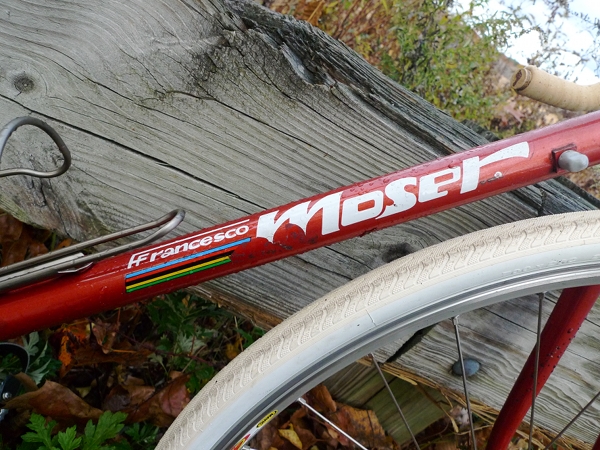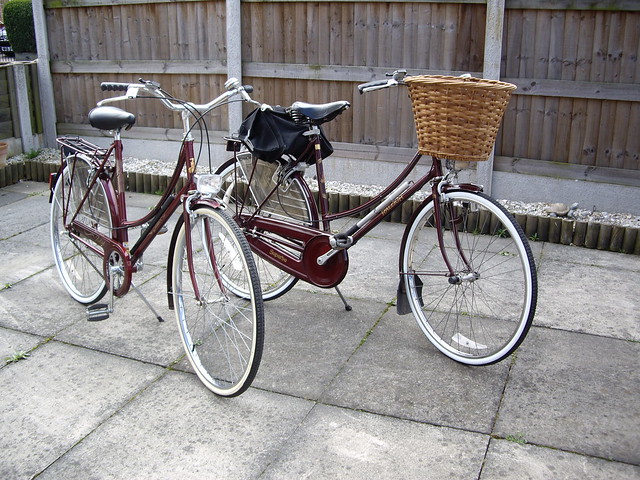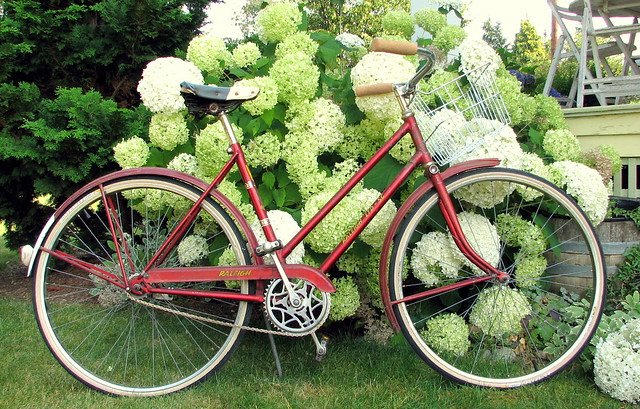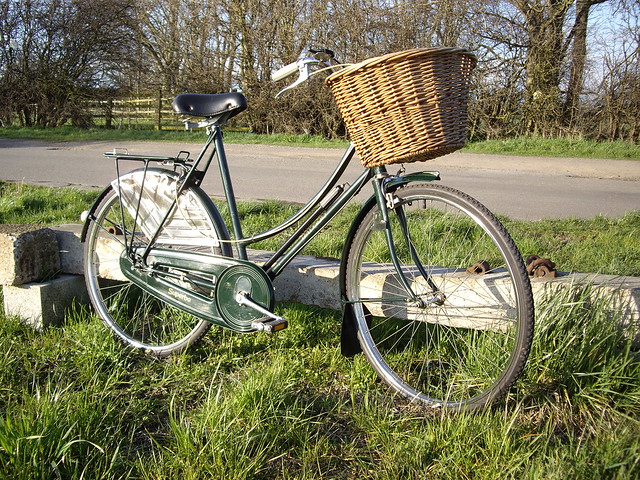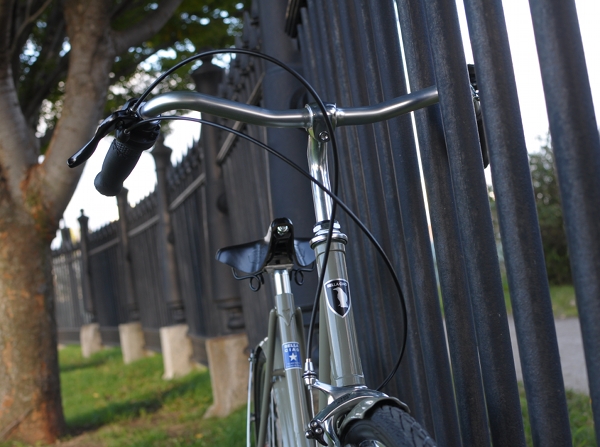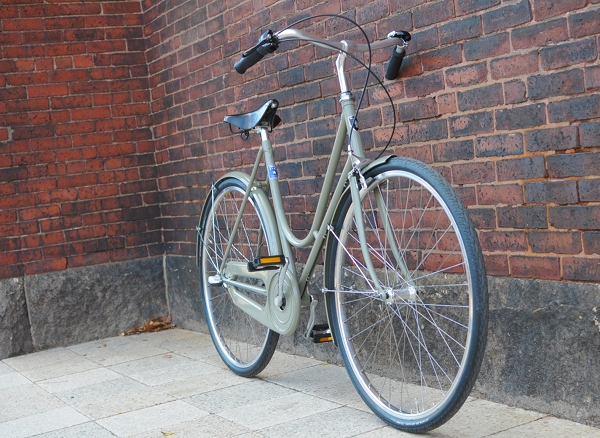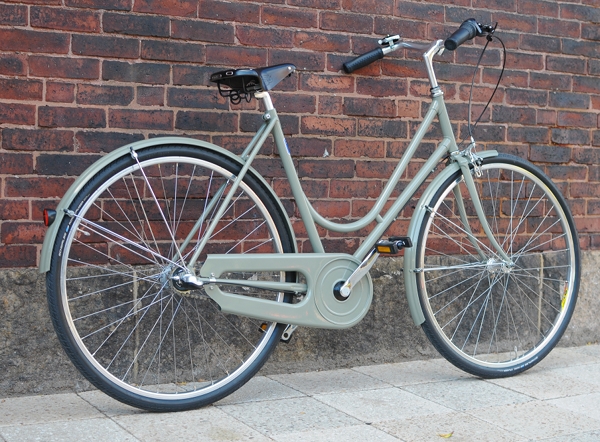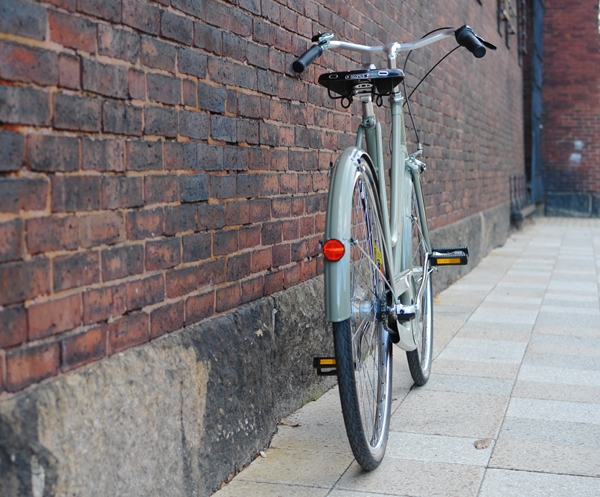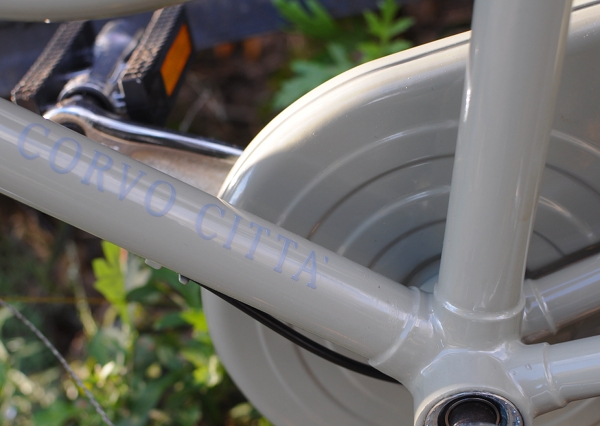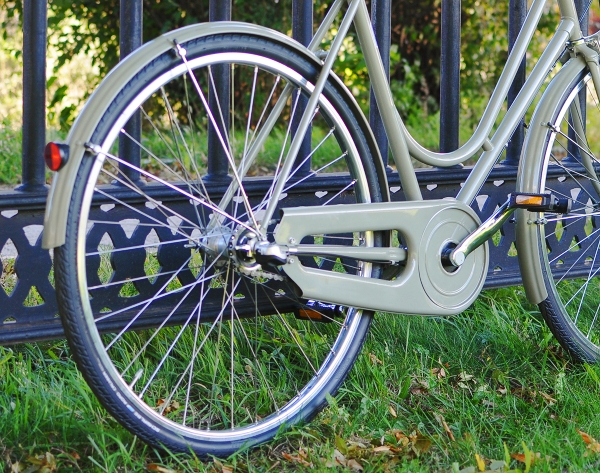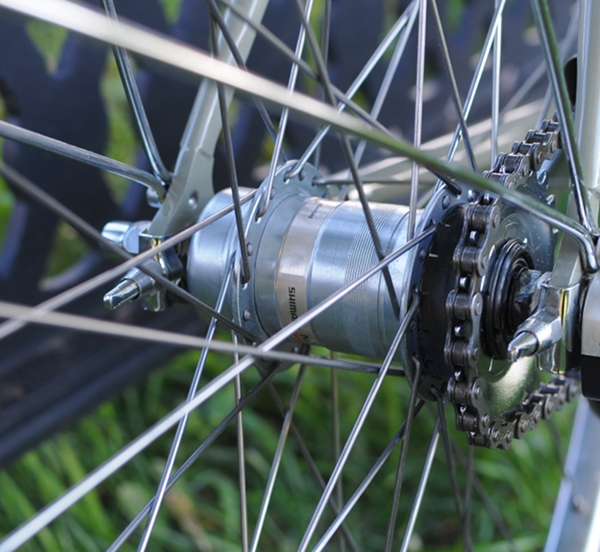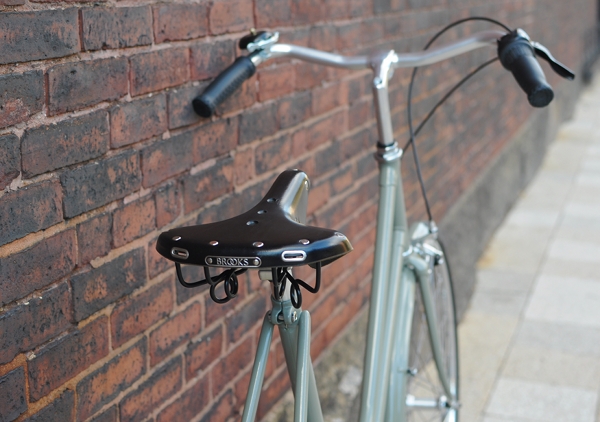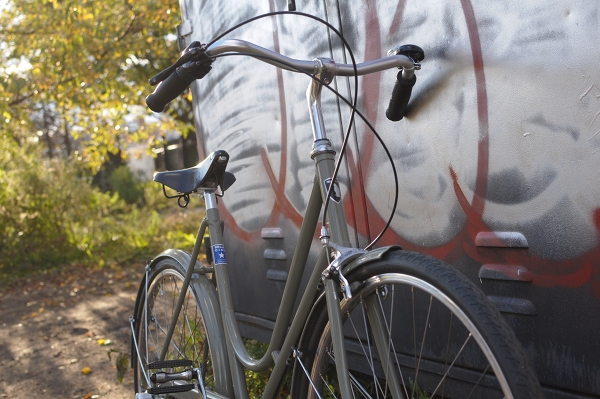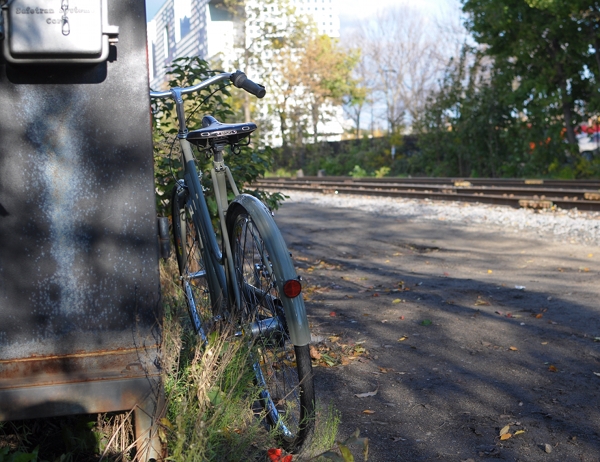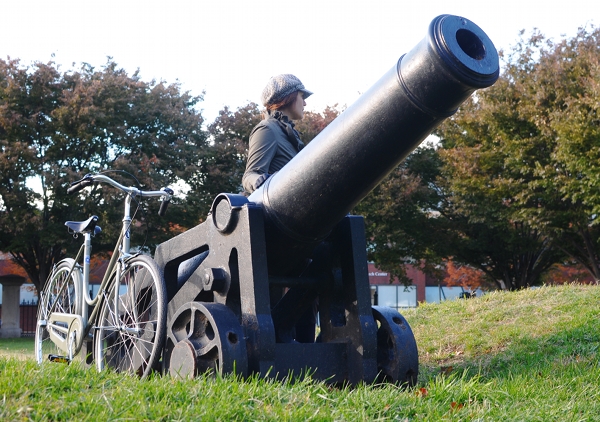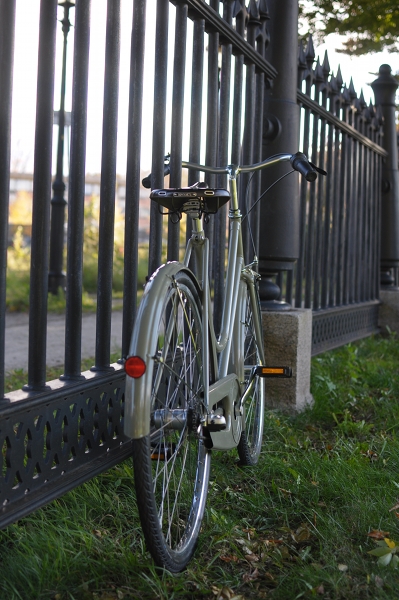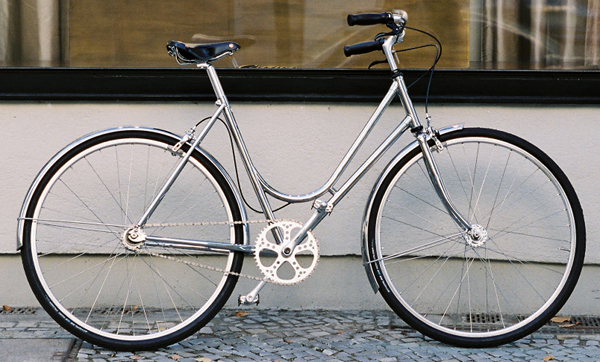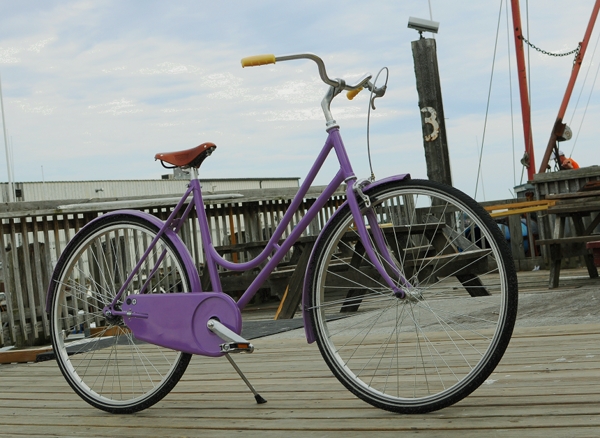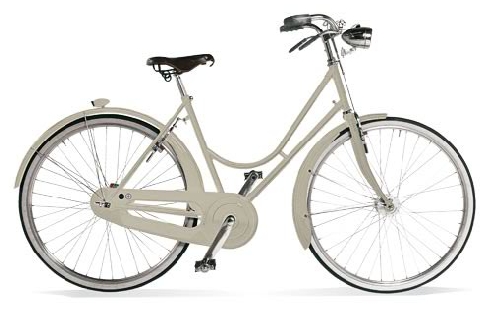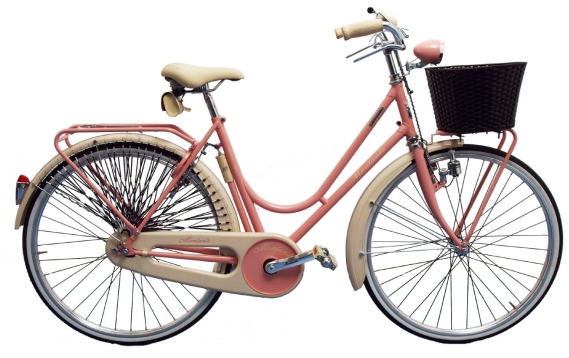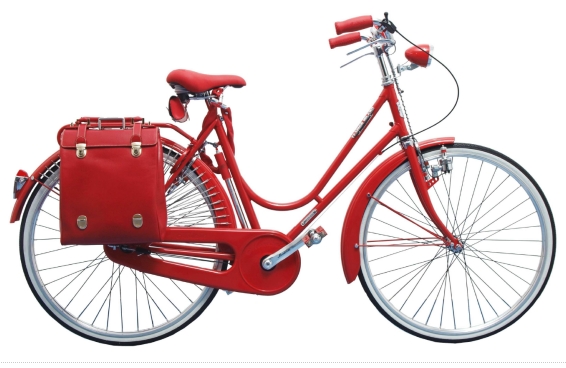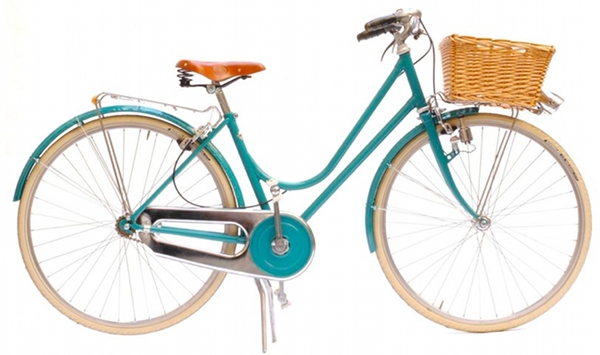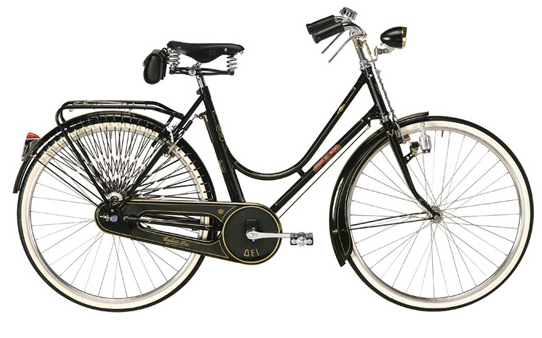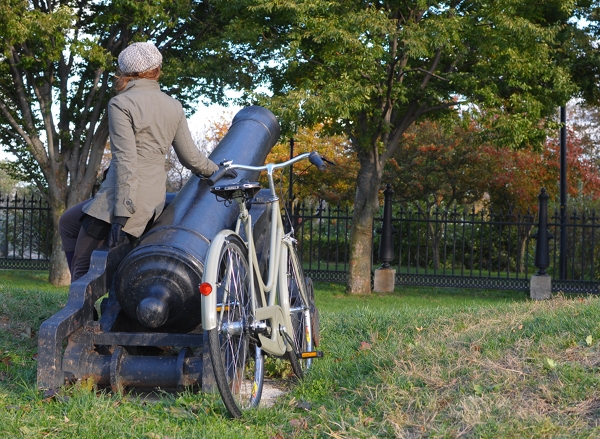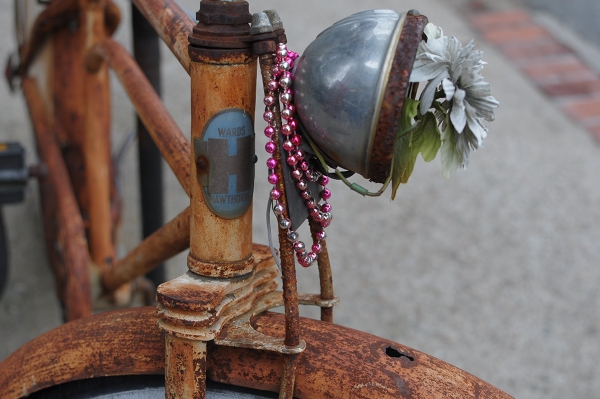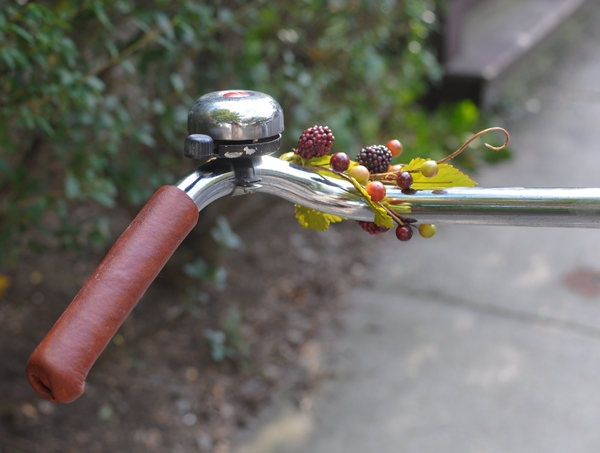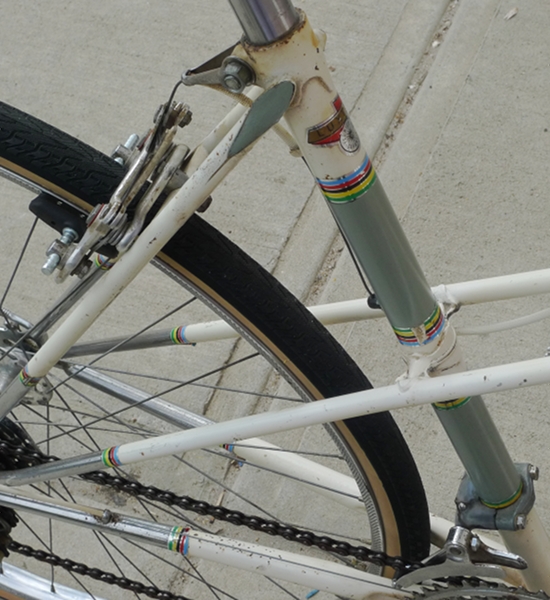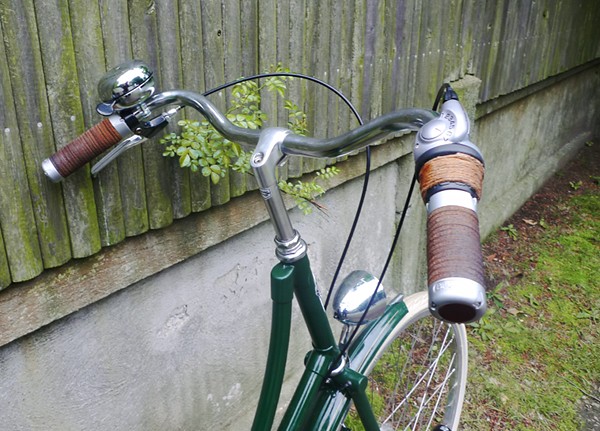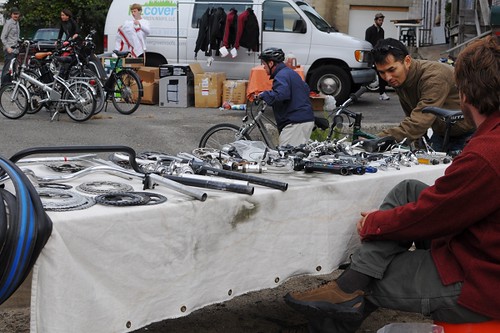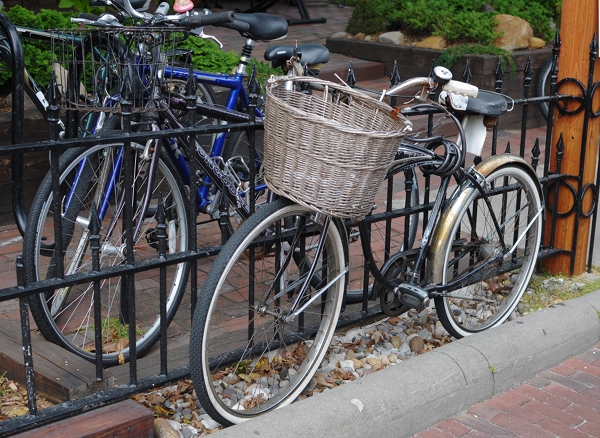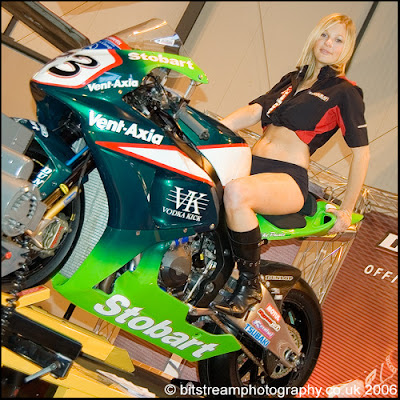|
|
|---|
Saturday, October 30, 2010
The Masked Cyclist: a Halloween Tale
It was a dark, crisp Autumn night many years ago and I was a mere high school girl, cycling home from piano lessons on my step-through mountain bike. The nonfunctional shifters and rusty chain emitted eerie creaking sounds as I rode through the nocturnal New England streets. My path was illuminated by moonlight, since my bicycle had no lights. Suddenly, I glimpsed something out of the corner of my eye - a moving shadow perhaps? I stopped, with a screech of my poorly adjusted brakes.
At first, I saw nothing at all. But soon, an image began to materialise before me.
And then, there she stood: the Masked Cyclist!
We had all heard of her, but only the very few had seen her - and never this closely. Legend had it, the Masked Cyclist haunted the roads of our town, clad in Edwardian garments and astride an old bicycle - her urgent pleas getting lost in the howling of the wind. What did she want? No one knew, but we all feared her intense gaze.
As I stood frozen in place, the Masked Cyclist moved closer and closer toward me - until suddenly we were face to face. "Who are you, and want do you want?" I managed to utter.
"I am the Masked Cyclist," said she, "and I am not at peace, because the beautiful bicycles that used to roam our land so famously have been all but exterminated by sinister forces. Many decades ago, these streets were full of ladies in their finery, gliding mirthfully through town and through farmland on their trusty loop frames with delightful chaincases, dressguards and lights. But now everything is dark and silent, and our towns are empty, and our farmlands have been replaced with strip malls, and the few bicycles in existence are carelessly built monstrosities that bring little joy to their owners. No, this is too horrifying and I cannot rest. Will you help me?"
"But how can I help?"
"I see that you enjoy riding your bicycle, and I pity you for its poor quality and lack of proper accoutrements. If you agree to help me bring the joy of lovely bicycles to our people, I shall be able to rest. You need only tell me that you agree, and the rest will be taken care of."
I looked at her lovely, ghostly bicycle, and without knowing what came over me, I agreed. "Thank you!" she said to me. "You shall go home now and forget all about our little talk. But 13 years from now I will visit you again to thank you."
And so it was. That same evening, I fell asleep and forgot all about my encounter with the Masked Cyclist, and life took its course. Little did I know that the otherworldly creature had decided to possess me, biding her time until the day was right to create Lovely Bicycle. Ignorant of the Masked Cyclist's influence, I knew not what compelled me to write post after post about lugs, loop frames, dynamo lighting, and local frame builders. And thus it continued for over a year, until a fortnight ago. I was cycling home along a popular bicycle commuter route when the Masked Cyclist once again appeared before me. Suddenly I remembered everything. But instead of fear, I was filled with affection - as I now shared the Masked Cyclist's devotion to lovely bicycles.
"Masked cyclist!" I exclaimed, "Is that you?"
"It certainly is," she replied, "I have come to thank you for helping restore the glory of lovely bicycles to our land. Once again, I see many happy ladies gliding along our streets on their comfortable, trusty bikes, and I am finally able to rest with the knowledge that things are improving."
"But there is still so much work to do," said I, "surely you are not leaving me?"
"Don't be sad," replied the Masked Cyclist. "It is time for me to go now. But my spirit will continue to guide you. And so that you always remember, I leave you my own bicycle. Please take it and cherish it always."
And with those words, the Masked Cyclist disappeared. I have not seen her since, but I can feel that her spirit is at peace.
Friday, October 29, 2010
2011 BMW 550i Review
Happy Feet
Continuing with the Italian theme, I took Francesco - my fixed gear stallion. How happy he was, basking in the precious minutes of sunshine in between thunderstorms.
Riding a fixed gear roadbike is an experience that fills me with a special kind of enjoyment - I think because it combines the sensations of walking and flying (fly-walking?).
I was worried that I might be too out of shape to make it, but I had forgotten how comfortable Francesco is. The 26 miles of pedaling felt like a stroll in the park. Although, I have learned by now that even if I feel "fine" riding fixed gear while I am actually doing it, it does take more out of me than a free-wheel bicycle. I usually sleep longer after such a ride, and sometimes I am sore the following day.
One thing that has improved my comfort level with fixed gear cycling considerably, are these "fixie" Power Grips. I wrote about the standard Power Grips here, and since my initial review I have become addicted to these things. The fixed gear version differs from the standard model, in that it makes it easier to insert and remove your feet while pedals are in motion. I cannot tell what it is about the design that makes this possible, but none the less it seems to work. I insert my right toe at the starting position and start cycling slowly while nudging the left pedal with my left toe - then swiftly insert the toe into the left grip on the first stroke. After some practice this became a familiar and instinctive sequence of movements - though it definitely helped that I was already comfortable using this system on a free-wheel bike prior to trying it on a fixed gear.
Now that I am able to use foot retention on this bicycle, I am no longer apprehensive about cycling over bumps and potholes or going downhill at high speeds. The experience is pretty much perfect and very enjoyable. One thing in particular I have noticed, is how easy it is for me to ride "in the drops" - Francesco almost seems more stable when the handlebars are held this way than higher up. Is that possible?
And another interesting thing: I find it much, much easier to get out of the saddle and pedal standing up on Francesco than I do on my other bicycles. Is it the fixed-gearness that is facilitating this or the geometry? As I've mentioned before, I have a terrible sense of balance, and that is what I believe normally prevents me from pedaling while standing up. But on this bicycle, it seems not to matter.
It rained on and off for the duration of our ride, and the colourful leaves strewn over the trail turned into a mess of a slippery carpet. Was I so excited to be riding Francesco that I began to imagine things, or is it easier to ride in slippery conditions on a fixed gear bike? I have read comments about traction before, but I admit that I don't understand them. Could somebody explain it in layman's terms?
As I prepare for some more pruning of my bicycle overgrowth, it is clear to me that I "need" a fixed gear roadbike. So while I am now considering selling my Trek - which has been fun, but not essential - I will definitely be keeping the Francesco Moser.
In the long run, however - maybe a couple of years from now - I will probably want to replace it with a "real" fixed gear bicycle. Mainly, this is because the Moser's bottom bracket is not as high as it should be - and even though my lean on turns is not aggressive enough to warrant worrying about pedal strike yet, it would be better if this wasn't even a potential issue.
But for now, Francesco is my dashing Italian gentleman and I thank him for my happy feet.
Dodge today introduced the new Dodge Avenger 2011, totally overhauled for 2011 with an all-new interior, a redesigned exterior and performance attributes that put the "fun" in functional. A new powertrain lineup and completely redesigned and retuned suspension mean drivers will experience Dodge's fun-to-drive dynamics in a front-wheel-drive mid-size sedan.
automobile news
The Avenger's fun-to-drive quotient rises exponentially for 2011 with a significantly upgraded suspension to give drivers agile, confident, handling performance in all driving situations, whether it's a spirited adventure on twisty roads or an emergency maneuver. Dodge engineers retuned or redesigned virtually every part of the suspension for 2011, including 26 of 30 suspension bushings. The suspension and the geometry were completely rethought. The track is an inch wider, tire width increased from 215 to 225 millimeters and the vehicle is 12 millimeters lower in the front and 6 millimeters in the rear for a more aggressive stance. Customers will feel more confident when driving the new Avenger because of less body roll, less vehicle shake, improved isolation, better steering precision, response and feel and the increased grip of new premium tires. breaking news today
A new and improved powertrain lineup also contributes to the 2011 Avenger's driving experience. The vehicles has a standard 2.4-liter World Gas Engine, which has been recalibrated and is now available mated to a new smooth-shifting six-speed transmission for an exceptionally fun and fuel-efficient driving experience. Avenger customers also can opt for the new Pentastar V-6 engine mated to a six-speed automatic transmission that gives customers the best of both worlds – best-in-class 283 horsepower (an increase of 20 percent compared with the engine it replaces) and 260 lb.-ft. of torque (an increase of 12 percent) combined with competitive fuel economy. ferrari 458 italia review
2011 Porsche Cayenne S Hybrid in Dealer Showrooms this November
breaking news today
Like most hybrids the Cayenne S Hybrid can drive for a time on electric power alone at speeds up to 37 mph. However, it delivers efficiencies at cruising speeds through its ability to ’sail’ or coast with the combustion engine turned off. It can do this for up to one mile, and this not only saves fuel but also minimizes emissions. automobile news
In the Cayenne and Panamera model lines the ‘S’ designation indicates a V8 under the hood. But the ‘S’ in the Cayenne S Hybrid name is there for a different reason, to indentify the true performance character of this SUV’s highly sophisticated parallel full hybrid system. With a combined power output of 380 horsepower from the supercharged V6 combustion engine and an electric motor, the Cayenne S Hybrid delivers performance nearly equal to the Cayenne S with its 400-horsepower V8 and fuel economy estimates that exceed those of the Cayenne with the V6 engine.
The all-new Porsche Cayenne has earned some significant awards since going on sale this summer. It is the 2011 Motor Trend Sport/Utility of the Year® and also recently received the Auto Pacific Motorist Choice Award for Best Premium Active Lifestyle Vehicle.
Nissan recalls 2.1 million vehicles
Thursday, October 28, 2010
Lovely Bicycles on a Budget: Vintage vs Modern
In addition to the variety of comments posted on this website, I receive lots of questions from readers via email. And if I had to say what the one most frequently asked question is, it would be a variation of this one:
I am looking for a nice bicycle for commuting around town and my budget is $500. I would love to get a new Dutch bike or a Pashley, but I just can't afford it. What would you recommend in my price range?Now, I do have a page on this website called Budget Options, and a link to it is prominently displayed in the upper lefthand corner. On that page I keep an updated list of manufacturers that sell budget versions of classic bicycles for as little as $150. I also have a page on shopping for vintage bikes. So, in emailing me the above question, the reader is usually looking for more than to be directed to one these pages. They are looking for my opinion: What would I do with $500? What do I recommend of all the possible options?
Okay, if you really want to know, I'll tell you. But I can almost guarantee that you won't like it and that you won't follow my recommendation. Do you want to hear it anyway? Well, all right. I would recommend buying a vintage 3-speed and spending the remainder of your budget on modernising it. Here is how I would do it:
Step 1:
Buy a vintage Raleigh Lady Sports in your size and preferred colour. Make sure the frame is in good condition, and that as many components as possible are salvageable. Try to spend under $100 on this purchase, and absolutely no more than $150. It is possible if you do some research and ask around. Even if there is a shortage of vintage bikes in your area, post a "want to buy" ad on your local C-List and chances are someone will dig one out of their basement or barn. Or join bikeforums and a kind enthusiastic soul on the Classic & Vintage subforum will provide you with some local contacts. It can be done if you are motivated.
Step 2:
Buy a modern 26" (ISO 590) wheelset with alloy rims and a 3-speed hub built into the rear wheel (the shifter is usually included). The biggest problem with using vintage 3-speeds for transportation, is that they have caliper brakes and steel rims - a combination that provides inadequate stopping power in wet weather conditions. An alloy wheelset will solve this problem. Several bike shops sell such wheelsets online at reasonable prices: A Sun wheelset from Harris Cyclery will set you back $200. An Alex wheelset from Niagra Cycle Works will set you back $130. Your local bike shop might be able to order a wheelset from a catalogue as well.
Step 3:
Buy a set of 26" (ISO 590) tires with puncture protection. Schwalbe Delta Cruisers in either black or cream are a good choice, because they look classic, make for a very comfortable ride, and cost only $40 for the pair.
Step 4:
Assuming that you are not skilled in bicycle repair, maintenance or assembly, bring your vintage bike and all the parts to a trusted local shop. Ask them to replace the wheelset, put on the new tires, and give the bicycle a thorough tune up. They will probably end up replacing the chain and some cables as part of that process as well. It should run you about $100.
Step 5:
If the vintage bike you found did not come with a saddle and there is room in your budget, get a Brooks or a lower-priced VO leather saddle. If you are tapped out, look for a vintage saddle, or buy a cheap generic one as a temporary fix until you save up the extra money for a new, quality one.
At the end of this process, you will have a bicycle with all the comfort, durability and charm of a vintage 3-speed, but with modern braking power. It should last pretty much forever and should feel great to ride. Yes, organising the bike will be a small adventure - but again, it can be done if you put your mind to it.
Having said that, I realise that most of my readers will opt out. For one thing, it seems difficult and time-consuming. It also probably seems absurd to spend a total of $500 on a vintage 3-speed, when you could go to the store and get one of these for the same price, brand new and shiny. I sincerely understand that. But...
Consider that the second most frequently asked question I get from readers over email is a variation of this one:
Three months ago I bought a [Budget Manufacturer X] bicycle, because my budget was $500. Actually, I ended up spending a bit more than that, because I got the 7-speed version. And Basil panniers. And a Brooks saddle. And cork grips. But anyway, I thought the bicycle looked nice and I liked how it rode when I tested it outside the bike shop. But it's only been 3 months, and now my rear fender is making clunking noises, and my chain has come off twice, and I keep getting flat tires. Also, the bike doesn't feel that great over pot-holes and my hands start to hurt on the handlebars towards the end of my commute from work. My bike shop says that I can update some of the components to fix these problems, but it looks like that's going to cost me another several hundred dollars. I am not sure what to do now. What do you think?I never know quite how to answer that one, because at that point the person has already maxed out their budget. Any suggestions? And yes, I am perfectly serious that I get these emails. I respect it when people say they are on a tight budget and I would like to be helpful with solutions instead of saying "save up for a better quality bike". But I honestly cannot think of a solution that I truly believe in other than my vintage 3-speed plan. I have never received an email from anybody complaining about their vintage Raleigh Sports.
Dodge Charger Prototype : first drive
you need to get the latest news today?
Wednesday, October 27, 2010
Southtowne Hyundai of Newnan releases the all new 2011 Hyundai Sonata
With beaming grins and news of Hyundai being named the most fuel efficient brand in America, Hyundai's brass took the wraps off their new-for-2011 Sonota. What strikes you instantly is the Sonata's curvy, slightly-hefty, almost organic shape. Hyundai calls the design language "Fluidic Sculpture," and while not quite as in-your-face as Mazda's signature Nagare styling language, we have a feeling it might prove nearly as polarizing. That's not to say the new Sonata is bad looking or ugly. But it is highly-stylized in a mid-size market that tends to reward the bland and middle-of-the-road.
hyundai sonata 2011 turbo
But Fluidic Sculpture is what we've got – and not just on the Sonata. Hyundai's North American President and CEO John Krafcik promises that this design language will define the brand moving forward. Not surprisingly, Fluidic Sculpture originated right here in Southern California in Hyundai's Irvine design center. We really appreciate some of the finely wrought detailing, such as the grille, door handles, headlights and taillights (though those taillights appear to be lifted directly from the BMW 3 Series). We're just a wee bit uncertain of how the new Sonata will play in Peoria.
As for the non-design aspects of the 2011 Sonata, the big car news is under the hood. Gone is the 3.3-liter V6, or for that matter, any V6. Instead Hyundai is offering consumers a choice of three four-cylinder engines. The first is a 2.4-liter Gasoline Direct-Injection (GDI) motor called the Theta II good for 198 horsepower and 184 pound-feet of torque. That much power from a 2.4-liter essentially puts the Sonata at the head of the four-cylinder class. But what about those pesky V6 cars? No problem, as Southtowne Hyundai of Newnan will introducing a turbocharged version of the GDI Theta II. If direct-injection and turbocharging sounds a little EcoBoosty to you, well, it is. And that's a very, very. automobile news
A Raven Flies Through the City: The Bella Ciao Corvo Citta Donna
The bicycle is a Bella Ciao "Corvo Citta Donna". The model name translates into something like "urban raven" and donna indicates that it is the lady's version. The colour (chosen by me) is "verde arsenale" - a pastel army green. Half a dozen other colours are available as well. The "Corvo Citta" models can be ordered as single speeds, 3-speeds, or 7/8-speeds, with or without coaster brake. I asked for a 3-speed coasterbrake version. The accessories are either honey or black, depending on the frame colour, and mine came with the black accessories package.
Bella Ciao frames are individually hand-made (brazed and lugged) by a small family-owned manufacturer in Northern Italy that has been building frames for generations. The standard models are cro-moly steel, though there are also limited editions made of Columbus tubing. Standard features on the Corvo Citta Donna include the classic Italian frame construction, 700C wheels with alloy rims, body-coloured fenders, an enclosed chaincase with a rear opening, leather saddle and grips, rear reflector, and a brass bell.
The frame is made in size 54cm (21.5") only, measured the "standard" way. This is an important point, especially if you are trying to compare the Bella Ciao to the Abici, whose sizing is measured differently. I would say that the Bella Ciao frame is slightly larger than the bigger of the two Abici frames.
With its hardy tubing, modest lugwork, and thick powdercoating, the "Corvo Citta" is attractive, but decidedly utilitarian.
It is not a delicate bicycle by any means; the frame feels as if it can take anything that life has to offfer.
The lugged fork crown warms my heart; very nicely done. And look at the body-coloured cable guide braze-ons.
The only part of the frame that is not lugged, is the connector between the curved top tube and downtube. But if I have to choose between this and the fork crown, the latter is infinitely more important to me. (The connector on my Pashley was not lugged either.)
I like the elegant chaincase, and the interesting thing, is that despite being steel it is absolutely silent.
Somewhat disappointing though, was the choice of the Shimano 3-speed hub and gear shifter for such a classic bicycle. The Shimano certainly works fine, but the excruciatingly high-tech looks of the hub and shifter disrupt the bicycle's classic charm. Personally, I feel it would have been better to use the Sturmey Archer hub and shifter on these bikes - though I suspect others will disagree.
The Bella Ciao has straight fork ends, which I prefer on an internally geared hub bicycle. There are also chain tensioners installed - a detail the Co-Habitatant found especially exciting.
The bicycle arrived to me with a Brooks B17S saddle, but I immediately replaced it with a B72. I am not sure why both Bella Ciao and Abici use B17 saddles on their city bikes, but I think they need to rethink this choice - it is not an appropriate model for an upright ride, especially for women. The B72, on the other hand, feels absolutely at home here.
As long as I am doling out criticism, I will also mention my perplexity over the choice of brake lever: I believe it may be an interruptor lever, because it is very short. The Tektro front caliper brake provides excellent stopping power and the lever is squeezable, but it's just not the right one for this type of bicycle. A normal, full-size city lever would be more suitable.
The minimal insignia on the Bella Ciao include a small headbadge on the head tube featuring the black raven logo, the "Corvo Citta" model name inscription near the bottom bracket, and a "fatto a mano in Italia" sticker on the seat tube.
And one thing I should definitely mention is the handlebars - which are proprietary Bella Ciao. They are shaped similarly to Porteur handlebars, but with just a tad more flare-out to them. The shape is super comfortable for my hands and seems perfectly matched to this bicycle's geometry.
Moving on to ride quality... The most notable sensation I got from the Bella Ciao, was that it did not feel like a new bicycle. It felt very familiar, like an old bike that I have always owned. Lovers of classic bicycles complain that "there is no such thing anymore as a simple, well-made, lugged steel 3-speed bike". Well, I think the Bella Ciao is exactly that. It is easy. It is comfortable. It is uncomplicated. It is not as laid back as a Dutch bike, but definitely not too sporty either (more relaxed than an Abici). It is maneuverable but unaggressive. It is just a bike. A very nice bike that anybody can ride, and that is light enough for anybody to lift.
When a bicycle is this easy, comfortable and undemanding, you end up riding it all the time... which, ironically, ushers in my next complaint: Where are the lights? And more importantly, where is the rack? I would love to ride the Bella Ciao regularly for transportation, but there is nowhere to attach my bag and all the other stuff I take along, which is frustrating. The design of the bicycle will accommodate the VO Constructeur rear rack, and when I have the money I might get one. But I think that a rack in the style you see on some of these bicycles would be more appropriate. Anybody know where I could source one?
The Bella Ciao "Corvo Citta Donna" might just be the closest I have tried to an "all around, normal" bike out there today among classic lugged bicycles. And that was rather unexpected, given the quirkiness of the manufacturer's self-presentation. Free-association collages, stories of resistance against fascism - it is enough to raise the eyebrows of some and to make others wonder whether Bella Ciao is in reality a contemporary art project rather than a real bicycle company. Well, I suppose there is no reason it can't be both...
Though currently only sold in the EU, Bella Ciao is considering North American distributors and the bicycles may be available for sale in the US sometime in 2011. The Corvo Citta Donna would certainly be welcomed by women looking for more options in classic city bicycles.
Dodge Charger Prototype : first drive
As Chrysler pulls itself back from the brink for the
eleventy-seventh time, it's poised to roll out 16 new or significantly revamped
cars in the coming months, six of which will be Dodges. Most will wear the
brand's remodeled crosshair grille, and all will be better differentiated from
their Chrysler siblings in terms of ride, handling, and basic attitude. Leading
this charge is the refreshingly reskinned Charger.
you need to get the latest news today?
Tuesday, October 26, 2010
The new RCZ
you need to get the latest news today?
Cadillac XLR Platinum Edition
you need to get the latest news today?
A Closer Look at Italian City Bicycles
As slyly mentioned in the comments of several previous posts, I recently received an Italian bicycle from Bella Ciao, of which a test ride report is forthcoming. Some who have noticed the bike asked about the difference between it and the Abici I test rode earlier, noting the similarities of the designs. So I thought I would take this opportunity to showcase some ladies' Italian city bicycles - and to point out that the frame is not a similarity between Abici and Bella Ciao per se, but a common design feature of Italian bicycles in general - one that differentiates them from the more familiar loop frames of Dutch and English bikes. From the "Mrs. Cinelli" bicycle I photographed at the Larz Anderson show, to the myriad of bicycles spotted in Rome by Chic Cyclists, this distinct "Frascona curve" has been a classic element of the elegant lady's transport bike in Italy for decades.
Monday, October 25, 2010
The Bicycle, and on Building (and Protecting) Your World
How does the bicycle tie into this?... I cannot yet verbalise it as eloquently as I would like, but I know for certain that it does. Maybe disentangling myself from one aspect of societal expectations and life's inertia made me realise that it was generally possible. Prior to getting a bicycle, I had made some radical changes in my life, and have continued to make others since. Those changes have made me considerably worse off financially, but the quality of my life improved. And most importantly, I feel that I have re-claimed my intellect and creativity, which I now understand was necessary for my sense of personal integrity.
When I ride a bicycle, I experience a heightened awareness of the extent to which we are the architects of our own worlds. Things don't just happen to us, as we like to think when feeling helpless about our situations. Whether we realise it or not, we orchestrate our daily experiences through a complex web of choices and decisions we make - which includes the choice to be passive and let our circumstances, or other people around us, shape our world for us. To live the life we want to live, we must actively build and protect it - not violently or smugly, but committedly and persistently, even if others don't understand us or criticise our choices. For me, this is an important parallel between cycling and life in general.
Sunday, October 24, 2010
Making a Bicycle Your Own
1. Address functionality and comfort before looks. Prior to buying colourful panniers and covering the bike with flower garlands, make sure the saddle position and handlebar height are properly adjusted for your proportions and postural preference. You may be surprised how much just that factor alone can change the "personality" of the bicycle. And this, in turn, will better inform subsequent aesthetic choices.
2. Personalising the looks of your bicycle need not involve buying lots of costly accessories. Some of the most delightful decorations are also the least expensive. Consider that things like ribbon, faux florals, twine, and stickers can cost mere pocket change. A simple bow in your favourite colour on the handlebars, or some flowers along the edge of your basket, will create an instant, lively transformation. And if you have an old bicycle with scratched up paint? You could turn it into a "zebra bike", "tiger bike", or "bumble bee bike" by wrapping appropriately coloured electrical tape around the frame to create stripes.
Of course, with an older bicycle there is also the option of using paint. You could try lug outlining, hand-painting small panels, or even painting your own designs along the entire frame. In Europe I see bicycles hand-painted with flowers, polka-dots, zebra stripes, peace symbols, lady bugs, and all sorts of other simple motifs. A paint pen for lug outlining will set you back around $2. Enamel paint will cost around $6 for a small can.
3. Avoid formulaic accessorising. If you saw it in a magazine or on a popular blog, chances are that so did hundreds of others. Do you really want to spend all that money on limited edition saddles, deluxe grips and exotic tires, just to end up with a bicycle that looks identical to lots of other bikes? Take the time to consider what combination of things would suit you individually, rather than trying to recreate a popular look.
4. Explore ways to trade and barter with other bicycle owners. The components you no longer want might be just what another person is looking for, and vice-versa. This is considerably more affordable than buying everything new, and can yield interesting results. I acquired some of my best stuff via trades, including saddles, dress guards, a rack, and even an entire bicycle!
In the end, the bicycles that are the most striking and feel the most "yours" are those that reflect your personality - regardless of the budget that went into achieving that.

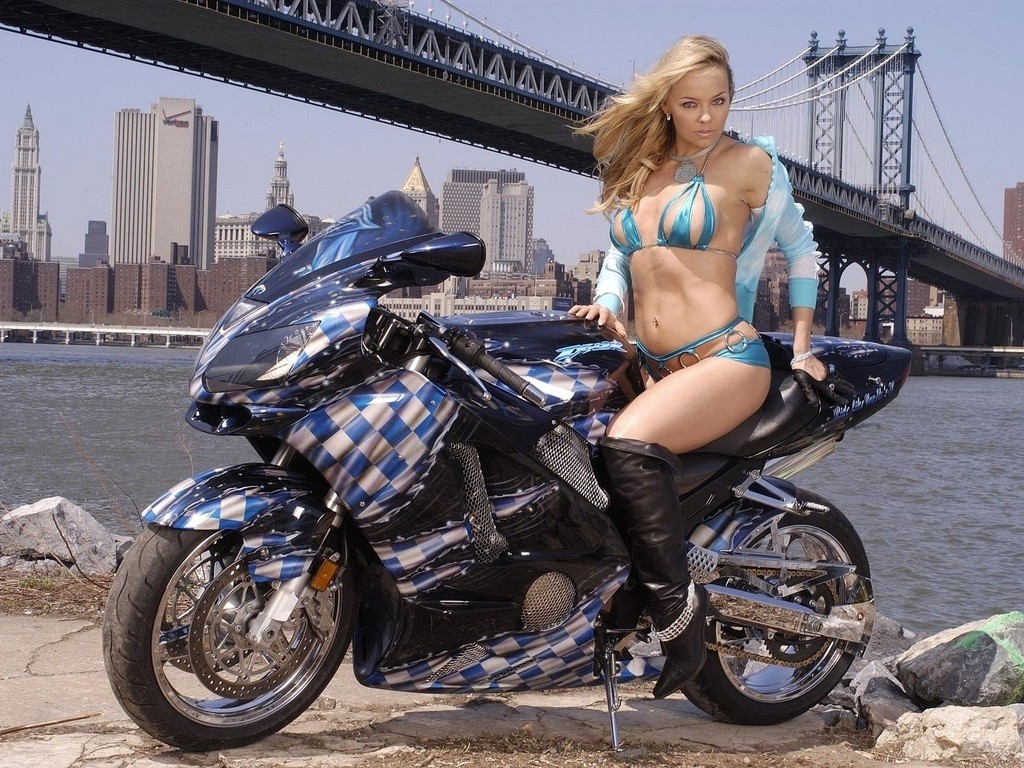





.jpg)

